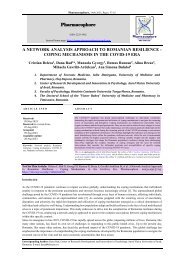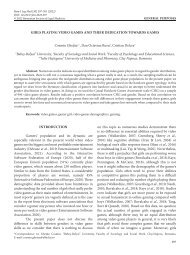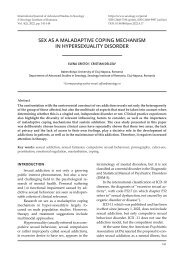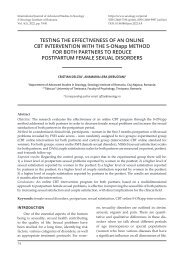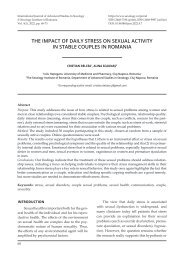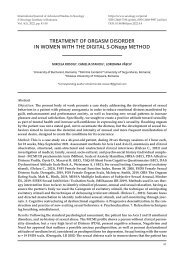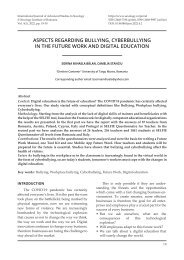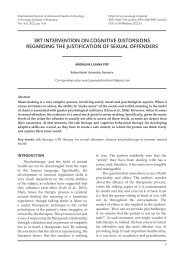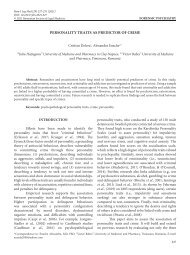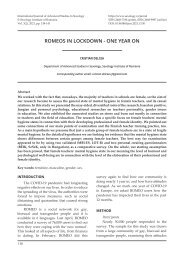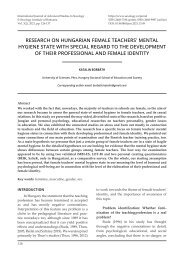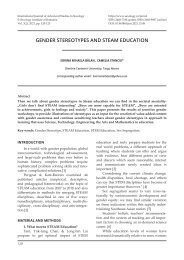PREDICTIVE FACTORS OF VIOLENT CRIME
The work aims to capture the specific peculiarities of the profile of the violent criminal, addressing the issue of assuming responsibility as well as the importance of maladaptive cognitive schemes in violent criminals. The research was conducted on 126 participants, subgrouped according to criminal history. Data were collected with the Young cognitive Schema Questionnaire in its short form (YSQ-S3) for the assessment of maladaptive cognitive schemas and the ROSENZWEIG Frustration Test for the assessment of attribution of responsibility. The results highlighted the links between maladaptive cognitive schemas and the assumption of responsibility, as well as the tendency of violent offenders to assign responsibility to external sources.
The work aims to capture the specific peculiarities of the profile of the violent criminal, addressing the issue of assuming responsibility as well as the importance of maladaptive cognitive schemes in violent criminals. The research was conducted on 126 participants, subgrouped according to criminal history. Data were collected with the Young cognitive Schema Questionnaire in its short form (YSQ-S3) for the assessment of maladaptive cognitive schemas and the ROSENZWEIG Frustration Test for the assessment of attribution of responsibility. The results highlighted the links between maladaptive cognitive schemas and the assumption of responsibility, as well as the tendency of violent offenders to assign responsibility to external sources.
You also want an ePaper? Increase the reach of your titles
YUMPU automatically turns print PDFs into web optimized ePapers that Google loves.
Rom J Leg Med [30] 196-199 [2022]<br />
DOI: 10.4323/rjlm.2022.196<br />
© 2022 Romanian Society of Legal Medicine<br />
GENERAL PURPOSE<br />
<strong>PREDICTIVE</strong> <strong>FACTORS</strong> <strong>OF</strong> <strong>VIOLENT</strong> <strong>CRIME</strong><br />
Costel Siserman 1 , Manuela Gyorgy 2 , Cristian Delcea 1,*<br />
1<br />
“Iuliu Hațieganu” University of Medicine and Pharmacy, Cluj-Napoca,<br />
2<br />
“Dimitrie Cantemir“University of Targu Mures, Romania<br />
Abstract. The work aims to capture the specific peculiarities of the profile of the violent criminal, addressing the<br />
issue of assuming responsibility as well as the importance of maladaptive cognitive schemes in violent criminals. The research<br />
was conducted on 126 participants, subgrouped according to criminal history. Data were collected with the Young cognitive<br />
Schema Questionnaire in its short form (YSQ-S3) for the assessment of maladaptive cognitive schemas and the ROSENZWEIG<br />
Frustration Test for the assessment of attribution of responsibility. The results highlighted the links between maladaptive<br />
cognitive schemas and the assumption of responsibility, as well as the tendency of violent offenders to assign responsibility to<br />
external sources.<br />
Keywords: Maladaptive cognitive schemas, responsability assuming, violent offenders.<br />
INTRODUCTION<br />
The specialized literature approached<br />
over time from multiple perspectives the issue<br />
of the association between irrational cognitions<br />
and violence [1]. Cognitive schemes are mental<br />
structures of related concepts, organized and adapted<br />
to the reality of each individuals life. Cognitive<br />
schemas are considered to be structured as semantic<br />
networks, having several characteristics that ensure<br />
flexibility [2] Maladaptive cognitive schemas are<br />
beliefs outlined in early childhood, which operate<br />
inn the background of the awareness and include<br />
expectations about life and social relations. These<br />
are the frameworks through the lens of which the life<br />
experience is organized [3].<br />
Their flexibility is determined by the<br />
characteristics they present, there being a network of<br />
categories and associated sub-categories, such as a<br />
criminal schema includes a sub-schema for car theft,<br />
another sub-schema for informational crime and many<br />
other associated sub-activated schemas [2].<br />
Numerous studies have addressed the issue of<br />
the link between maladaptive cognitive schemas and<br />
criminal behavior [4, 5], emphasizing the fact that these<br />
mental patterns lead to irresponsible and maladaptive<br />
consequences and also further antisocial and criminal<br />
behavior [6].<br />
This research aims to highlight the specific<br />
features of the profile of the violent criminal,<br />
representing a serie of particularities, starting from<br />
the premise that there are individual differences in the<br />
act of murder [7]. Thus, the objective is to highlight<br />
differences of responsability assignement, as well as<br />
in the context of the presence of some maladaptive<br />
cognitive schemes in violent criminals.<br />
PARTICIPANTS<br />
The research included a sample of 126 female<br />
(49%) and male (51%) adult participants (N=126),<br />
including inmates and individuals with no criminal<br />
history. The average age of the sample is 35.9 (SD=14.2/<br />
Min.=18, Max.=56). In terms of educational level, The<br />
sample was divided according to the criminal history<br />
into a group of participants without a criminal history<br />
(N=42), the group of prisoners convicted of crimes<br />
against bodily integrity (N=42) and a group of prisoners<br />
convicted of other crimes (N=42), subgrouped<br />
according to gender.<br />
The group without criminal history<br />
The sample with no criminal history included<br />
*Correspondence to: Cristian Delcea, “Iuliu Hațieganu” University of Medicine and Pharmacy, Cluj-Napoca, Romania,<br />
E-mail: cristian.delcea.cj@gmail.com<br />
196
42 female and male participants (N=42), evenly<br />
distributed. The average age is 33.21 (SD=8.72, Min.=<br />
18; Max.=56).<br />
The group of prisoners with criminal history<br />
against bodily integrity<br />
The sample with criminal history against bodily<br />
integrity consists of 42 (N=42) prisoners convicted<br />
of murder and fatal blows, subgrouped according to<br />
gender. The average age is 32.14 (SD = 6.83, Min.=19;<br />
Max.=42).<br />
The group of prisoners convicted for other crimes<br />
The sample with a criminal history convicted<br />
for other crimes consists of 42 (N=42) prisoners<br />
convicted of crimes of theft and trafficking in dangerous<br />
substances, subgrouped according to gender. The mean<br />
age is 25.22 (SD = 9.61, Min.=18; Max.=39).<br />
METHODS AND INSTRUMENTS<br />
Instruments<br />
In order to collect the raw data, the Young<br />
Cognitive Schema Questionnaire in its short form<br />
(YSQ-S3) was used, to evaluate maladaptive cognitive<br />
schemas and the Rosenzweig Frustration Test, to<br />
evaluate the attribution of responsibility.<br />
Data processing<br />
Data were processed using SPSS software<br />
(Statistical Package for the Social Science) version<br />
Predictive factors of violent crime<br />
Table 1. Sample composition by maladaptive cognitive schemas and responsability assumption<br />
2.6. Descriptive statistics and correlation test were<br />
performed. The significance level is set to p≤0.05.<br />
RESULTS<br />
The statistical analysis included the following<br />
maladaptive cognitive schemes such as Mistrust/Abuse,<br />
Insufficient Self-control and Emotional Inhibition,<br />
respectively the responsibility assignment that can be<br />
assigned to oneself, to someone else or not assigned to<br />
anyone.<br />
Preliminary results<br />
The descriptive statistical analysis aimed<br />
to assess maladaptive cognitive schemas and how<br />
responsibility is assigned. This analysis is proceeded for<br />
the whole sample. Descriptive indices are included in<br />
Table 1.<br />
Statistical analysis indicates an average of<br />
15.42 (SD=2.78 / Min.= 8; Max.=20) for Mistrust/<br />
Abuse, for Insufficient Self-control an average of 14.69<br />
(SD=6.11 / Min.= 9; Max .=24) and for Emotional<br />
Inhibition an avarage of 20.12 (SD=8.31/ Min.=12;<br />
Max.=28). Regarding responsibility assignment, for Self<br />
assigned responsibility we obtained an average of 37.21<br />
(SD=10.12 / Min.=35.1 ;Max.=42.6), an average of 46.36<br />
(SD= 8.38 / Min.=35.7 ;Max.= 54.3) for Responsibility<br />
assigned to someone else and an average of 35.04 (SD=<br />
4.52 / Min.= 32.2 ; Max.=38.6) for Responsibility is not<br />
assigned to anyone.<br />
Maladaptive cognitive schema N Min. Max. Mean SD<br />
Mistrust/Abuse 126 8 20 15.42 2.78<br />
Insufficent Self control/ Self –Discipline 126 9 24 14.69 6.11<br />
Emotional inhibition 126 12 28 20.12 8.31<br />
Responsability assumption N Min. Max. Mean SD<br />
Self assigned responsability 126 35.1 42.6 37.21 10.12<br />
Responsability assigned to someone else 126 35.7 54.3 46.36 8.38<br />
Responsability is not assigned to anyone 126 32.2 38.6 35.04 4.52<br />
Table 2. Correlation coefficients between maladaptive cognitive schemas and responsability assumption and the threshold significance<br />
Pearson Correlation coefficient (r)<br />
Self assigned responsability<br />
Mistrust/Abuse (MA) .141 .169<br />
Emotional inhibition (EI) .268* .025<br />
Insufficient Self-Control/ Self-Discipline (IS) .209 .243<br />
Responsability assigned to someone else<br />
Mistrust/Abuse (MA) .593** .000<br />
Emotional inhibition (EI) .681** .000<br />
Insufficient Self-Control/ Self-Discipline (IS) .245* .013<br />
Responsability is not assigned to anyone<br />
Mistrust/Abuse (MA) .201 .261<br />
Emotional inhibition (EI) .172 .105<br />
Insufficient Self-Control/ Self-Discipline (IS) .211 .319<br />
Sig. (p)<br />
197
Siserman C. et al.<br />
A comparative analysis was also carried out<br />
that focused on age differences at the level of the groups<br />
proposed in the research. Preliminary results indicated<br />
no significant differences between the three participant<br />
groups.<br />
Maladaptive cognitive schemas and assuming<br />
responsibility<br />
In order to identify the existence of a direct<br />
relationship between maladaptive cognitive schemas<br />
and the assignment of responsibility, a correlation study<br />
was proceeded between the way in which the individual<br />
attributes responsibility (oneself, to someone else or<br />
does not attribute it to anyone) and the maladaptive<br />
cognitive schemas (Table 2).<br />
No significant correlations were found<br />
between Self-assigned responsibility and Mistrust/<br />
Abuse and Insufficient Self-Control/Self Discipline.<br />
No significant correlations were found between<br />
Responsibility is not assigned to anyone and Mistrust/<br />
Abuse, Emotional Inhibition and Insufficient Self-<br />
Control/Self-Discipline.<br />
Differences in maladaptive cognitive schemas<br />
related to the type of crime<br />
The research aimed to identify the potential<br />
differences found for maladaptive cognitive schemas<br />
taking into account the type of crime committed.<br />
Thus, a comparative study was proceeded out with the<br />
ANOVA test.<br />
The statistical analysis indicated the existence<br />
of significant differences in Mistrust / Abuse F (2.381;<br />
p=.001) at the level of the three groups. Inmates from the<br />
group with crimes against bodily integrity (M=17.23/<br />
SD= 4.11) present a higher level for Mistrust/Abuse<br />
than the group of inmates with other crimes (M= 10.92/<br />
SD=.31), respectively the control group (M=9.14/<br />
SD=1.34).<br />
Significant differences were also identified in<br />
the case of Emotional inhibition (F=1.024/ p=.000)<br />
for the three groups. The highest level of Emotional<br />
Inhibition appears in the group of prisoners with crimes<br />
against bodily integrity (M= 25.17 / SD=3.29), followed<br />
by the group with prisoners convicted of other crimes<br />
(M=23.35/ SD= 1.92) and the group without criminal<br />
history (M =15.30 / SD= 4.21).<br />
Regarding Insufficient Self-control/ Self-<br />
Discipline we obtained significant differences between<br />
the three groups (F= 4.271; p= .015). Thus, the lowest<br />
level was found in the group without criminal history<br />
(M=12.52/ SD= 3.18), followed by the group of<br />
prisoners convicted of other crimes (M=14.23 / SD=<br />
1.12) and the highest level is present for the group of<br />
prisoners convicted of crimes against bodily integrity<br />
(M=20.32 / SD=2.49)(Fig. 1).<br />
Differences of responsability assumption related<br />
to the type of crime<br />
Responsibility assignment was analyzed for<br />
each group under analysis. The ANOVA analysis did<br />
not reveal significant differences for Self-assigned<br />
responsibility between the three groups.<br />
No differences were identified between the<br />
three groups in terms of not assigning responsibility to<br />
anyone. There were identified significant differences in<br />
the tendency to assign responsibility to someone else<br />
(F=2.914; p=.000).<br />
Inmates convicted of crimes against bodily<br />
integrity have the most significant tendency to attribute<br />
responsibility to someone else (M= 51.65/ SD = 8.45),<br />
followed by those convicted of other crimes ( M= 46.23<br />
/ SD= 9.27) and the group with no history criminal<br />
(M= 38.91/ SD=6.31)(Fig. 2).<br />
DISCUSSION<br />
Following the analysis, it was found that<br />
the sample has a grater prevalence of cognitive<br />
schemes like Emotional inhibition, which implies<br />
Figure 1. Differences of maladaptive cognitive schemas regarding<br />
the type of crime.<br />
198<br />
Figure 2. Differences in the level of attribution of responsibility<br />
according to the type of crimes.
Predictive factors of violent crime<br />
the tendency to inhibit the expression of positive and<br />
also negative emotions, manifesting itself through<br />
anger, aggressiveness, stopping others from showing<br />
intense feelings. Although emotional inhibition would<br />
presuppose self control originating either at a cultural<br />
or educational level, the sample shows a tendency<br />
of insufficient self control, maladaptive cognitive<br />
scheme characterized by impaired emotional tolerance,<br />
manifesting itself in impulsivity, unreliability and<br />
disorganization, focusing on short-term gratification<br />
and don't consider the consequences of their<br />
actions. Also, the maladaptive cognitive scheme of<br />
mistrust was identified, which implies the tendency to<br />
see others as untrustworthy, expecting the worst from<br />
them, manifesting itself by taking advantage of others,<br />
manipulating and abusing others [8, 9].<br />
Maladaptive cognitive schemes do not imply<br />
certain behaviors, being found both in the case of<br />
individuals without a criminal history and in those with<br />
a criminal history. Thus, the identification of potential<br />
associations between maladaptive cognitive schemes<br />
and the tendency to attribute responsibility to someone<br />
else was considered. Referring to the research sample,<br />
we found that there is a significant association between<br />
emotional inhibition and self assigned responsibility,<br />
which could be explained by the fact that the inhibition<br />
of emotions can lead to a tendency to self-blame. A<br />
strong association was also identified with the tendency<br />
to assign responsibility to an external source. Strong<br />
associations also exist between the tendency to blame<br />
others and mistrust, respectively insufficient self control<br />
[10].<br />
The analysis highlighted that inmates from the<br />
group of prisoners convicted for crimes against bodily<br />
integrity tend to have a higher level of maladaptive<br />
cognitive schemes, such as mistrust, emotional<br />
inhibition and insufficient self control, than inmates<br />
convicted for other crimes. The lowest level of cognitive<br />
schemas was identified in the group with no criminal<br />
history. Thus, confirming the premise of numerous<br />
studies according to which a high level of maladaptive<br />
cognitive schemes determines a predisposition to<br />
criminality [11].<br />
Regarding the method of assigning<br />
responsibility, it was highlighted that inmates<br />
convicted for crimes against bodily integrity tend<br />
to assign responsibility to an external source, rather<br />
blaming the victims for the situation. The differences<br />
identified between prisoners convicted of other<br />
crimes and those convicted of crimes against bodily<br />
integrity are significant, which may indicate that the<br />
tendency to assume responsibility for the facts could<br />
be more meaningful depending on the type of crimes<br />
committed, there being a profile of the persons prone<br />
to this category of crimes.<br />
In conclusion, the presence of beliefs according<br />
to which the expression of positive and also negative<br />
emotions must be inhibited, insufficient self control<br />
and the tendency to see others as untrustworthy,<br />
expecting the worst from them, could be determining<br />
factors included in the profile of people predisposed to<br />
committing crimes against bodily integrity. Based on<br />
the results, the correct approach to the possibility of<br />
institutional re-education of prisoners in this category,<br />
as well as the specifics of intervention programs for<br />
their social reintegration, must be taken into account.<br />
Conflict of interest<br />
The authors declare no conflict of interest.<br />
References<br />
1. Harris A, Lurigio AJ. Mental illness and violence: a brief<br />
review of research and assessment strategies. Aggress Viol Behav.<br />
2007;12:542–551.<br />
2. Kellogg TR. Fundamentals of Cognitive Psychology. Sage<br />
Publications, Inc.sc, 2015.<br />
3. Delcea C. Maladaptive Cognitive Schemas and Decision Making”.<br />
In: Proceedings Of The International Conference on Legal Medicine<br />
from Cluj, 3 rd edition Vol. 2020. p. 145-152.<br />
4. Baker E, Beech AR. Dissociation and variability of adult<br />
attachment dimensions and early maladaptive schemas in sexual<br />
and violent offenders. J. Interpers. Violence. 2004; 19: 1119–1136.<br />
5. Chakhssi F, de Ruiter C, Bernstein DP. Early maladaptive cognitive<br />
schemas in child sexual offenders compared with sexual offenders<br />
against adults and nonsexual violent offenders: an exploratory<br />
study.” J. Sex. Med. 2013; 10: 2201–2210.<br />
6. Gonzalez R, Mandracchia JT, Nicholson B, Dahlen E. Exploring<br />
parenting as a predictor of criminogenic thinking in college students.<br />
Int. J. Offender Ther. Comp. Criminol. 2013; 58: 1081–1100.<br />
7. Delcea C, Enache A. Personality Traits as Predictor of Crime.<br />
Rom J Leg Med. 2021; 29 (2): 227-231.<br />
8. Delcea C, Siserman C, Validation and Standardization of the<br />
Questionnaire for Evaluation of Paraphilic Disorders. Rom J Leg<br />
Med. 2020; 28(1)14-20.<br />
9. Popa-Nedelcu R, Delcea C, Siserman C, Carmen Domnariu DC,<br />
2020: The relationship between personality disorders and domestic<br />
violence in forensic context. Rom J Leg Med. 2020; 28(2):166-171.<br />
10. Müller-Fabian A, Siserman C, Anițan SM, Delcea C. Juvenile<br />
delinquency in light of data recorded at the Institute of Forensic<br />
Medicine. Rom J Leg Med. 2018; (26): 70-75.<br />
11. Gherman C, Enache A, Delcea C. The multi-factorial<br />
determinism of forensic expertise regarding sentence interruption<br />
on medical grounds and decision. Journal of Forensic and Legal<br />
Medicine. 2018; (61): 45-55.<br />
199




